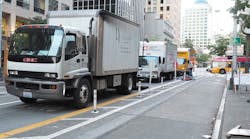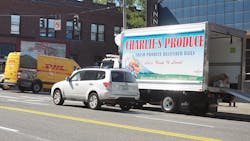For years, the next step in routing technology has been folding in layers of data of all kinds. According to Chris Wickman, a consultant with PTV Group, routing can not only be tailored to a fleet's operations and duty cycles but to an individual truck. The company's routing and logistics software reaches back decades and serves as a foundation for a number of other routing applications today.
You might have a truck with a given gross combined vehicle weight, for example, that the routing system can take into consideration, Wickman explained. When planning and optimizing routes and rerouting as necessary, the system could note particular roads with weight restrictions that would affect the truck, vehicle restrictions based on time of day, and so on.
What about the truck's cargo? A route-planning solution might need to factor in things like a particular road's altitude that could damage that freight, noted Bill Maddox, vice president of sales for ALK Technologies, a commercial routing and mapping company owned by Trimble with products like the PC*MILER route management platform now in its 32nd iteration.
Route planning can even improve safety for a fleet's trucks. Yes, the first consideration is typically cost, so a fleet will look to optimize drivers' routes by minimizing distance traveled and time spent getting to and loading/unloading at stops, connecting the dots between those stops as efficiently as possible. But there are many further nuances to consider.
"For eight stops, there are more than 40,000 different combinations that you can do," pointed out Mike Becker, director of routing transformation at PepsiCo North American Beverages. He used a simple example of route-planning and scheduling software mapping around those stops geographically from first to last or the other way around, delivering two different, lasso-like pathways.
"One good thing about this solution," he said about the first option running geographically clockwise, "is that all of those stops except one is a right-hand turn." That alone reduces the time it takes to run the route, he noted, even though running the stops in the opposite direction "is the same exact distance."
"That's also better from a safety perspective," Becker added. "Taking left-hand turns with a commercial vehicle tends to create more accidents instead of a right-hand turn scenario."
Kevin Frey, director of warehousing and distribution at school meals manufacturer and distributor Preferred Meals, said a fleet similarly can consider the nature of certain roads when planning for unexpected changes. The company uses fleet management systems provider Omnitracs' Roadnet Anywhere route-planning technology.
It's situations outside the routine that can challenge a fleet most. For instance, a truck could break down unexpectedly, snarling carefully crafted route plans.
"If there's a mechanical issue with a truck, we send out a substitute vehicle with a new driver, and we'll load up all the product" from the disabled truck, Frey explained. "We'll kind of back one up to the other—just literally take all of the product and move it onto the operating vehicle—and then the replacement driver continues the route."
"We can very accurately tell the driver that's going out where they're going to meet the broken-down driver, and we can also map out what's the best vector of approach," he noted. The disabled truck might be along a highway, "so you know the replacement driver will be going from high speed to a quick stop. How do you effectively approach that without causing another accident?"
In addition to nearly limitless layers of data that can influence and be folded into route planning and optimization, there are add-on services and processes that can boost customer service, streamline operations, and further reduce costs for the fleet.
"If you've got an in-cab telematics system, you can feed information back to the transportation office as drivers are executing those routes," said Will Salter, CEO of commercial routing and scheduling company Paragon Software Systems. "That enables the transportation office to monitor the routes, and you can keep customers informed by SMS [text] or email automatically. If there's a delay or they're going to be missed, all that information can be fed back during the day as the routes are executed."
Proof of delivery is another example. Drivers can document that a parcel or shipment has been delivered, relay photos of the goods and any damage, and provide feedback on particular requirements for a delivery location such as clearing a locked gate—there are myriad possibilities of data inputs now informing and supplementing distribution, and again, your competitors may be using these systems.
"If you're the company that's got routing and scheduling systems and you've invested in all this technology and you're next to your competitor that hasn't," Salter pointed out, "guess who's going to have the advantage in the marketplace?"




